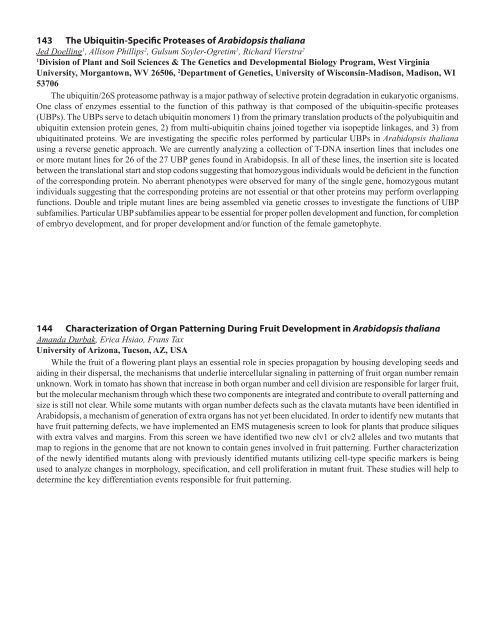75 Integrating Membrane Transport with Male Gametophyte ... - TAIR
75 Integrating Membrane Transport with Male Gametophyte ... - TAIR
75 Integrating Membrane Transport with Male Gametophyte ... - TAIR
You also want an ePaper? Increase the reach of your titles
YUMPU automatically turns print PDFs into web optimized ePapers that Google loves.
143 The Ubiquitin-Specific Proteases of Arabidopsis thaliana<br />
Jed Doelling 1 , Allison Phillips 2 , Gulsum Soyler-Ogretim 1 , Richard Vierstra 2<br />
1<br />
Division of Plant and Soil Sciences & The Genetics and Developmental Biology Program, West Virginia<br />
University, Morgantown, WV 26506, 2 Department of Genetics, University of Wisconsin-Madison, Madison, WI<br />
53706<br />
The ubiquitin/26S proteasome pathway is a major pathway of selective protein degradation in eukaryotic organisms.<br />
One class of enzymes essential to the function of this pathway is that composed of the ubiquitin-specific proteases<br />
(UBPs). The UBPs serve to detach ubiquitin monomers 1) from the primary translation products of the polyubiquitin and<br />
ubiquitin extension protein genes, 2) from multi-ubiquitin chains joined together via isopeptide linkages, and 3) from<br />
ubiquitinated proteins. We are investigating the specific roles performed by particular UBPs in Arabidopsis thaliana<br />
using a reverse genetic approach. We are currently analyzing a collection of T-DNA insertion lines that includes one<br />
or more mutant lines for 26 of the 27 UBP genes found in Arabidopsis. In all of these lines, the insertion site is located<br />
between the translational start and stop codons suggesting that homozygous individuals would be deficient in the function<br />
of the corresponding protein. No aberrant phenotypes were observed for many of the single gene, homozygous mutant<br />
individuals suggesting that the corresponding proteins are not essential or that other proteins may perform overlapping<br />
functions. Double and triple mutant lines are being assembled via genetic crosses to investigate the functions of UBP<br />
subfamilies. Particular UBP subfamilies appear to be essential for proper pollen development and function, for completion<br />
of embryo development, and for proper development and/or function of the female gametophyte.<br />
144 Characterization of Organ Patterning During Fruit Development in Arabidopsis thaliana<br />
Amanda Durbak, Erica Hsiao, Frans Tax<br />
University of Arizona, Tucson, AZ, USA<br />
While the fruit of a flowering plant plays an essential role in species propagation by housing developing seeds and<br />
aiding in their dispersal, the mechanisms that underlie intercellular signaling in patterning of fruit organ number remain<br />
unknown. Work in tomato has shown that increase in both organ number and cell division are responsible for larger fruit,<br />
but the molecular mechanism through which these two components are integrated and contribute to overall patterning and<br />
size is still not clear. While some mutants <strong>with</strong> organ number defects such as the clavata mutants have been identified in<br />
Arabidopsis, a mechanism of generation of extra organs has not yet been elucidated. In order to identify new mutants that<br />
have fruit patterning defects, we have implemented an EMS mutagenesis screen to look for plants that produce siliques<br />
<strong>with</strong> extra valves and margins. From this screen we have identified two new clv1 or clv2 alleles and two mutants that<br />
map to regions in the genome that are not known to contain genes involved in fruit patterning. Further characterization<br />
of the newly identified mutants along <strong>with</strong> previously identified mutants utilizing cell-type specific markers is being<br />
used to analyze changes in morphology, specification, and cell proliferation in mutant fruit. These studies will help to<br />
determine the key differentiation events responsible for fruit patterning.





